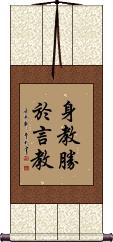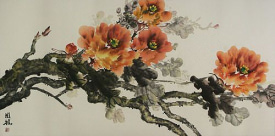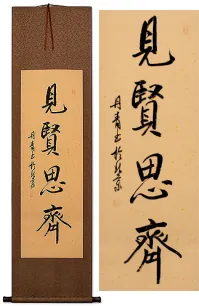Many custom options...
And formats...

Example in Chinese / Japanese...
Buy an Example calligraphy wall scroll here!
Example is Better than Precept
Tell somebody how to do something and they might get it.
Show them how to do it, and they will master it in no time.
身教勝於言教 can also be translated as “Behavior teaches more than words.”
See Also: Wisdom
This in-stock artwork might be what you are looking for, and ships right away...
Gallery Price: $100.00
Your Price: $49.88
Not the results for example that you were looking for?
Below are some entries from our dictionary that may match your example search...
| Characters If shown, 2nd row is Simp. Chinese |
Pronunciation Romanization |
Simple Dictionary Definition |
布施 see styles |
bù shī bu4 shi1 pu shih fuse ふせ |
More info & calligraphy: Dana: Almsgiving and Generosity(n,vs,vi) (1) {Buddh} alms-giving; charity; (n,vs,vi) (2) {Buddh} offerings (usu. money) to a priest (for reading sutras, etc.); (surname) Fuho dāna 檀那; the sixth pāramitā, almsgiving, i. e. of goods, or the doctrine, with resultant benefits now and also hereafter in the forms of reincarnation, as neglect or refusal will produce the opposite consequences. The 二種布施 two kinds of dāna are the pure, or unsullied charity, which looks for no reward here but only hereafter; and the sullied almsgiving whose object is personal benefit. The three kinds of dāna are goods, the doctrine, and courage, or fearlessness. The four kinds are pens to write the sutras, ink, the sutras themselves, and preaching. The five kinds are giving to those who have come from a distance, those who are going to a distance, the sick, the hungry, those wise in the doctrine. The seven kinds are giving to visitors, travellers, the sick, their nurses, monasteries, endowments for the sustenance of monks or nuns, and clothing and food according to season. The eight kinds are giving to those who come for aid, giving for fear (of evil), return for kindness received, anticipating gifts in return, continuing the parental example of giving, giving in hope of rebirth in a particular heaven, in hope of an honoured name, for the adornment of the heart and life. 倶舍論 18. |
見賢思齊 见贤思齐 see styles |
jiàn xián sī qí jian4 xian2 si1 qi2 chien hsien ssu ch`i chien hsien ssu chi |
More info & calligraphy: Learn from Wisdom |
身教勝於言教 身教胜于言教 see styles |
shēn jiào shèng yú yán jiào shen1 jiao4 sheng4 yu2 yan2 jiao4 shen chiao sheng yü yen chiao |
More info & calligraphy: Example is Better than Precept |
例 see styles |
lì li4 li rei / re れい |
example; precedent; rule; case; instance (1) example; instance; illustration; case; (2) precedent; (3) custom; habit; practice; usage; (surname) Kiyosaki an example |
前 see styles |
qián qian2 ch`ien chien mae まえ |
front; forward; ahead; first; top (followed by a number); future; ago; before; BC (e.g. 前293年); former; formerly (1) in front (of); before (e.g. a building); (n,adj-no,adv) (2) before; earlier; previously; prior; ago; (minutes) to (the hour); (noun - becomes adjective with の) (3) (the) front; frontal part; fore; head (e.g. of a line); (4) forward; ahead; (5) (in the) presence (of); in front (of someone); (can be adjective with の) (6) previous (e.g. page); prior (e.g. engagement); first (e.g. half); former (e.g. example); (suffix) (7) (after a noun or the -masu stem of a verb) (See 一人前・1) portion; helping; (8) front (of one's body or clothing); breast (of a coat, kimono, etc.); (9) privates; private parts; (10) (colloquialism) criminal record; previous conviction; (a) prior; (personal name) Misaki pūrva. Before; former, previous; in front. |
喩 see styles |
yù yu4 yü yui ゆい |
Japanese variant of 喻 (personal name) Yui Illustrate, example; to know 宗因喩q.v. The example (dṛṣṭānta) in a syllogism. |
榜 搒 see styles |
bǎng bang3 pang bō |
notice or announcement; list of names; public roll of successful examinees A placard, list; model, example. |
範 范 see styles |
fàn fan4 fan han はん |
pattern; model; example example; model; (surname, given name) Han Pattern, rule, method. |
譬 see styles |
pì pi4 p`i pi hi |
to give an example To compare, allegorize; like, resembling; parable, metaphor, simile. |
辟 see styles |
pì pi4 p`i pi heki へき |
penal law; variant of 闢|辟[pi4] false; punish; crime; law; ruler A prince, sovereign, lord; split; punish, repress; perverse; toady; quiet. |
量 see styles |
liàng liang4 liang ryou / ryo りょう |
capacity; quantity; amount; to estimate; abbr. for 量詞|量词[liang4 ci2], classifier (in Chinese grammar); measure word (n,n-suf) (1) quantity; amount; volume; capacity; portion (of food); (2) (See 度量・1) generosity; magnanimity; tolerance; (3) pramana (means by which one gains accurate and valid knowledge; in Indian philosophy); (surname, female given name) Ryō pramāṇa. Measure, capacity, length, ability; to measure, deliberate; a syllogism in logic, v. 比量. A syllogism, consisting of 宗 pratijñā, proposition; 因 hetu, reason; 喩 udāharaṇa, example; but the syllogism varies in the number of its avayava, or members. There are other divisions from 2 to 6, e.g. 現量 and 比量 direct or sense inferences, and comparative or logical inferences; to these are added 聖教量 arguments based on authority; 譬喩量 analogy; 義准 postulation, or general assent; and 無體 negation, or non-existence. |
類 类 see styles |
lèi lei4 lei rui るい |
kind; type; class; category; (classifier) kind; type; (bound form) to resemble; to be similar to (n,n-suf) (1) kind; sort; type; class; genus; order; family; (n,n-suf) (2) similar example; parallel; the like; (given name) Rui Class, species; to classify. |
一例 see styles |
yī lì yi1 li4 i li ichirei / ichire いちれい |
example; an instance one example |
三支 see styles |
sān zhī san1 zhi1 san chih san shi |
(三支比量) Three members of a syllogism: pratijñā宗 the proposition, hetu 因 the reason, udāharaṇa 喩the example; cf. 因明. |
上例 see styles |
jourei / jore じょうれい |
above example |
亀鑑 see styles |
kikan きかん |
pattern; example; model; paragon; mirror; (given name) Kikan |
事例 see styles |
shì lì shi4 li4 shih li jirei / jire じれい |
example; exemplar; typical case (noun - becomes adjective with の) example; precedent; case |
代表 see styles |
dài biǎo dai4 biao3 tai piao daihyou / daihyo だいひょう |
representative; delegate; CL:位[wei4],個|个[ge4],名[ming2]; to represent; to stand for; on behalf of; in the name of (noun, transitive verb) (1) representation; representative; delegate; delegation; (noun, transitive verb) (2) exemplification; typification; being representative of; being typical of; representative example; exemplar; model; (3) leader; (4) (abbreviation) (See 代表番号) switchboard number; main number |
似喩 see styles |
sì yù si4 yu4 ssu yü jiyu |
fallacious example; pseudo-example |
作例 see styles |
sakurei / sakure さくれい |
(1) model of writing; example of writing; (2) (See 例文) example sentence (in a dictionary); illustrative sentence |
佳例 see styles |
karei / kare かれい |
good example |
例え see styles |
tatoe たとえ |
(1) example; (2) simile; metaphor; allegory; fable; parable |
例し see styles |
tameshi ためし |
(irregular okurigana usage) precedent; example |
例句 see styles |
lì jù li4 ju4 li chü reiku / reku れいく |
example sentence haiku given as an example |
例如 see styles |
lì rú li4 ru2 li ju reinyo |
for example; for instance; such as it is like |
例子 see styles |
lì zi li4 zi5 li tzu |
case; (for) instance; example; CL:個|个[ge4] |
例文 see styles |
reibun / rebun れいぶん |
example sentence; illustrative sentence; model sentence |
例此 see styles |
lì cǐ li4 ci3 li tz`u li tzu reishi |
take this as an example |
例示 see styles |
lì shì li4 shi4 li shih reiji / reji れいじ |
to exemplify (noun, transitive verb) exemplification; illustrating by example |
例解 see styles |
reikai / rekai れいかい |
(noun, transitive verb) illustration; example |
Click here for more example results from our dictionary
The following table may be helpful for those studying Chinese or Japanese...
| Title | Characters | Romaji (Romanized Japanese) | Various forms of Romanized Chinese | |
| Example is Better than Precept | 身教勝於言教 身教胜于言教 | shēn jiào shèng yú yán jiào shen1 jiao4 sheng4 yu2 yan2 jiao1 shen jiao sheng yu yan jiao shenjiaoshengyuyanjiao | shen chiao sheng yü yen chiao | |
| In some entries above you will see that characters have different versions above and below a line. In these cases, the characters above the line are Traditional Chinese, while the ones below are Simplified Chinese. | ||||
Successful Chinese Character and Japanese Kanji calligraphy searches within the last few hours...







